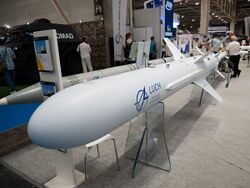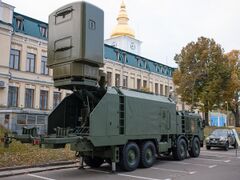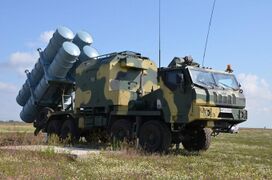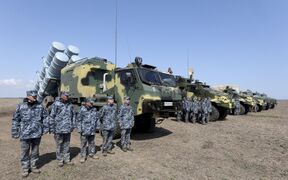Engineering:R-360 Neptune
| R-360 Neptune | |
|---|---|
 R-360 Neptune at Arms and Security exhibition 2021 | |
| Type | Anti-ship missile Cruise missile |
| Place of origin | Ukraine |
| Service history | |
| In service | 2021–present |
| Used by | Ukrainian Navy |
| Wars | Russo-Ukrainian War |
| Production history | |
| Designer | Luch Design Bureau[1] |
| Specifications | |
| Mass | 870 kg (1,920 lb)[1] |
| Length | 5.05 m (16.6 ft) |
| Diameter | 38 cm (15 in) |
| Warhead weight | 150 kg (330 lb) |
| Engine | Motor Sich MS400 turbofan |
Operational range | over 200 km (120 mi) up to 300 km (190 mi) [1][2][3] |
| Speed | Subsonic[1] |
R-360 Neptune (Ukrainian: Р-360 «Нептун») is a Ukrainian subsonic cruise missile with all-weather capabilities developed by the Luch Design Bureau in Kyiv. Originally designed as an anti-ship missile, an alternative model was fielded in 2023 with a new guidance system to support land-attack roles. With a range of over 200 kilometres, it is intended to neutralize naval targets up to 9,000 tonnes.
Neptune's design is based on the Soviet Kh-35 subsonic anti-ship missile, with substantially improved range, targeting and electronics equipment.[4][better source needed] The system requirement was for a single missile to defeat surface warships and transport vessels with a displacement of up to 9,000 tonnes, either in convoys or moving individually.
The first training missile divizion (battalion) entered service with the Ukrainian Navy in March 2021[5] with first operational naval use in 2022 and land-attack use in 2023.
Development
The missile was first revealed at the 2015 Arms and Security international exhibition in Kyiv.[6]
According to information from open sources, the first flight examples of the cruise missile were manufactured in the second quarter of 2016. Production of advanced missile systems took place in cooperation with other Ukrainian companies, including Artem Luch, Motor Sich (MS400 turbofan engine), ZhMZ Vizar Kyiv, Radionix (uk) (seeker) and Arsenal SDP SE (navigation system).[citation needed]
The first tests of the system were conducted on 22 March 2016, attended by Secretary of the National Security and Defense Council (NSDC) Oleksandr Turchynov. In mid-2017, Neptune missiles were tested concurrently with Vilkha launchers and missiles. The test results and capabilities of the Neptune were not made public, unlike those of the Vilkha.[7] According to the press service of the NSDC, the first successful flight tests of the system took place on 30 January 2018.[8] On 17 August 2018, the missile successfully hit a target at a range of 100 kilometres (62 mi) during test firings in southern Odesa Oblast.[9] On 6 April 2019, the missile was again successfully tested, hitting targets during tests near Odesa. According to President Petro Poroshenko, the Neptune system would be delivered to the Ukrainian military in December 2019.[10]
After the withdrawal of the United States and Russia from the Intermediate-Range Nuclear Forces Treaty, Ukraine announced that it was considering developing intermediate-range cruise missiles. Analysts considered an extended-range Neptune missile to be a candidate for such an effort.[11]
Ukraine signed a memorandum with Indonesia on concluding a contract for the supply of Neptune missiles, first reported in December 2020.[12] Thus, Indonesia may become the first foreign buyer of Neptune, according to Defense Express (uk) with reference to the Ukrainian special exporter State Enterprise (SE) "Progress".
In March 2021, the Ukrainian Navy obtained the first training missile battalion of the RK-360MC Neptune.[5]
Operational history
On 3 April 2022, during the Russian invasion of Ukraine, Ukrainian sources claimed that the Russian frigate Admiral Essen had been damaged by Ukrainian forces.[13] Later, Oleksiy Arestovych, a freelance adviser to the Office of the President of Ukraine, clarified that Admiral Essen had been hit by a Neptune missile. The Russians did not comment on the claim and the ship continued its mission as normal.[14][15]
On 13 April 2022, Ukrainian sources claimed the Russian cruiser Moskva was hit by two Neptune missiles, resulting in a fire and subsequent explosion of a shipboard ammunition store.[16] The Russian Ministry of Defence stated, without discussing the cause, that a fire had caused munitions to explode and the crew had been fully evacuated.[17][18][19] Russia reported the vessel as still being afloat later in the day of the fire, but Russian state media subsequently reported that she had sunk in inclement weather while being towed.[20][21]
According to Thomas Shugart, a former U.S. Navy submarine commander, Slava-class cruisers like Moskva have been typically "known for their offensive punch, not for their defensive systems or their damage control".[22] Moskva was one of the largest warships sunk in combat since World War II.[23] The successful use of the Neptune system to sink the warship was cited by Ukrainian Defence Minister Oleksii Reznikov as giving confidence to Ukraine's allies that more weapon supplies to Ukraine would be worth it.[24]
A land attack variant was being designed and, as of April 2023, was close to completion. The Neptune missile was initially designed to hit ships at sea. According to a Ukrainian official: "Ukraine is working to modify Neptune missile to strike land targets ... A new guiding/homing system is required, but Ukrainians are working on that ... Once we get that, the Neptunes can hit targets 360 km (about 225 miles) away. We are pretty close."[25]
On 23 August 2023, according to Ukrainian media reports, a modified R-360 missile was used to help destroy a S-400 missile system radar, deployed on Cape Tarkhankut in Crimea since 2016.[26][27] On 14 September, Ukrainian forces subsequently claimed to have destroyed S-400 missile systems near Yevpatoriya using drones and Neptune missiles.[28]
Design
When deployed, a Neptune coastal defence system comprises a truck-based USPU-360 mobile launcher, four missiles, a TZM-360 transport/reload vehicle, a RCP-360 command and control vehicle, and a special cargo vehicle. Czech Tatra T815-7 trucks replaced prototype KrAZ vehicles. The system is designed to operate inland up to 25 kilometres (16 mi) from the coastline.[5]
A Neptune missile including rocket motor is 5.05 metres (16 ft 7 in) in length, with a cross-shaped hard wing. Neptune missiles are designed to be housed in transport and launch containers with dimensions 5.3 by 0.6 by 0.6 metres (209 in × 24 in × 24 in). The system has a maximum range of about 300 kilometres (190 mi).[29][3] A single missile weighs 870 kilograms (1,920 lb), of which 150 kilograms (330 lb) is the warhead.[5] It uses a Motor Sich MS400 engine which has a high thrust-to-weight ratio.[30]
Gallery
Prototype KrAZ-7634-based launch vehicle
See also: other subsonic anti-ship missiles
- zarb (Pakistan)
- harba (Pakistan)
- VCM-01 (Vietnam)
- Atmaca (Turkey)
- Gabriel (Israel)
- Blue Spear (Israel – Singapore)
- Exocet (France)
- Harpoon (United States)
- RBS 15 (Sweden)
- Naval Strike Missile (Norway)
- SSM-700K C-Star (Republic of Korea)
- YJ-83 (China)
- Hsiung Feng II (Taiwan)
References
- ↑ 1.0 1.1 1.2 1.3 "Neptun Anti-Ship Cruise Missile". https://www.military-today.com/missiles/neptun.htm.
- ↑ "Error: no
|title=specified when using {{Cite web}}" (in uk). 2018-08-17. https://mil.in.ua/neptun-uspishno-vrazyv-morsku-cil/. - ↑ 3.0 3.1 "LUCH, State Kyiv Design Bureau". State Kyiv Design Bureau, LUCH. https://www.luch.kiev.ua/images/data/en/LuchEn.pdf.
- ↑ Episkopos, Mark (2019-02-06). "Ukraine Is Building Anti-Ship Missiles (In Part Thanks to Russia)". The National Interest. https://nationalinterest.org/blog/buzz/ukraine-building-anti-ship-missiles-part-thanks-russia-43532. Retrieved 2019-04-10.
- ↑ 5.0 5.1 5.2 5.3 Ponomarenko, Illia (15 March 2021). "Ukraine's navy acquires first Neptune cruise missiles". Kyiv Post. https://www.kyivpost.com/ukraine-politics/ukraines-navy-acquires-first-neptune-cruise-missiles.html. "The first training missile division joined the navy’s only artillery brigade on March 15, as part of the formation’s newly-created coastal defense missile battalion."
- ↑ (in uk). Espreso TV. 2015-09-24. http://espreso.tv/news/2015/09/24/fotofakt_u_kyyevi_prezentuvaly_novu_krylatu_raketu_neptun.
- ↑ Hristoforov, Vladislav (2018-01-25). "Error: no
|title=specified when using {{Cite web}}" (in uk). http://uprom.info/news/vpk/protikorabelna-raketa-neptun-proyshla-chastinu-viprobuvan-u-2017-rotsi/. - ↑ "Error: no
|title=specified when using {{Cite web}}" (in uk). 2018-01-30. http://mil.in.ua/pershi-vyprobuvannya-ukrayinskoyi-krylatoyi-rakety/. - ↑ "Ukrainian cruise missile "Neptune" struck a maritime target at a distance of 100 km during the test". 2018-08-17. https://en.ukrmilitary.com/2018/08/neptun.html.
- ↑ (in ru)Dzerkalo Tyzhnia. 2019-04-06. https://zn.ua/UKRAINE/rakety-neptun-postupyat-na-vooruzhenie-vms-v-dekabre-314032_.html.
- ↑ Peterson, Nolan (2019-03-13). "With an Eye to Russia, Ukraine Considers New Missiles After Cold War-Era Arms Control Treaty Collapses". https://www.dailysignal.com/2019/03/13/with-an-eye-to-russia-ukraine-considers-new-missiles-after-cold-war-era-arms-control-treaty-collapses/.
- ↑ "Indonesia to sign contract with Ukraine to purchase RK-360MC Neptune mobile missile coastal defense system". 2020-12-28. https://www.navyrecognition.com/index.php/naval-news/naval-news-archive/2020/december/9477-indonesia-to-sign-contract-with-ukraine-to-purchase-rk-360mc-neptune-mobile-missile-coastal-defense-system.html.
- ↑ "Украинские защитники повредили российский ракетный фрегат" (in ru). 3 April 2022. https://dumskaya.net/news/ukrainskie-zashchitniki-povredili-rossiyskiy-fre-162480/.
- ↑ Harding, Luke; Sauer, Pjotr; Borger, Julian; Elgot, Jessica (15 April 2022). "Russia's Moskva cruiser sinks following Ukrainian claim of missile strike". The Guardian. https://www.theguardian.com/world/2022/apr/14/russia-moskva-cruiser-sunk-stormy-seas-defense-ministry.
- ↑ Hambling, David (14 April 2022). "Ukraine's Bayraktar Drone Helped Sink Russian Flagship Moskva". Forbes. https://www.forbes.com/sites/davidhambling/2022/04/14/ukraines-bayraktar-drones-helped-destroy-russian-flagship/. Retrieved 16 April 2022.
- ↑ "Ukrainian military hits Russian cruiser by Neptune missiles". Ukrinform. 2022-04-13. https://www.ukrinform.net/rubric-ato/3456892-ukrainian-military-hits-russian-cruiser-by-neptune-missiles.html.
- ↑ "Fire breaks out onboard Moskva missile cruiser, crew evacuated — defense ministry". TASS. 14 April 2022. https://tass.com/emergencies/1437443.
- ↑ (in ru). RIA Novosti. 2022-04-14. https://ria.ru/20220414/kreyser-1783435471.html.
- ↑ Ljunggren, David (April 13, 2022). "Russia Says Ammunition Blast Damages Flagship of Black Sea Fleet - Interfax". U.S. News & World Report. Reuters. https://www.usnews.com/news/world/articles/2022-04-13/russia-says-major-ship-in-black-sea-fleet-badly-damaged-in-blast-interfax.
- ↑ "Russian warship Moskva: What do we know?". BBC News. April 14, 2022. https://www.bbc.com/news/world-europe-61103927.
- ↑ "Moskva cruiser sank while being towed in a storm — Russian Defense Ministry". TASS. April 14, 2022. https://tass.com/russia/1438045.
- ↑ Lendon, Brad (15 April 2022). "Moskva sinking: What really happened to the pride of Russia's fleet?". CNN. https://www.cnn.com/2022/04/15/europe/russia-guided-missile-cruiser-moskva-sinks-intl-hnk-ml/index.html.
- ↑ Mizokami, Kyle (15 April 2022). "Ukraine Sunk the Largest Warship Since WWII in a Major Blow to Russia". Popular Mechanics. https://www.popularmechanics.com/military/navy-ships/a39726517/russian-guided-missile-cruiser-moskva-sinks/. Retrieved 15 April 2022.
- ↑ Koshiw, Isobel; Beaumont, Peter (2022-12-15). "Putin preparing major offensive in new year, Ukraine defence minister warns" (in en). https://www.theguardian.com/world/2022/dec/15/ukraine-says-putin-is-preparing-major-offensive-in-new-year.
- ↑ ALTMAN, Howard (2023-04-14). "Ukraine Situation Report: Official Hints At New Weapons To Be Unleashed On Crimea" (in en). https://www.thedrive.com/the-war-zone/ukraine-situation-report-official-hints-at-new-weapons-to-be-unleashed-on-crimea.
- ↑ Axe, David (2023-08-25). "To Blow Up Russia's S-400 Battery In Crimea, Ukraine Tweaked Its Cruiser-Sinking Neptune Missile" (in en). https://www.forbes.com/sites/davidaxe/2023/08/25/to-blow-up-russias-s-400-battery-in-crimea-ukraine-tweaked-its-cruiser-sinking-neptune-missile/?sh=b4b65b357d3d.
- ↑ "Neptune anti-ship missile struck Russian S-400 radar in Crimea — report" (in en). 2023-08-25. https://news.yahoo.com/neptune-anti-ship-missile-struck-220700426.html.
- ↑ Ece Goksedef; Vitalii Chervonenko (14 September 2023). "Russian air defence system destroyed in Crimea, Ukraine says". BBC. https://www.bbc.com/news/world-europe-66805897.
- ↑ "Error: no
|title=specified when using {{Cite web}}" (in uk). 2018-08-17. https://mil.in.ua/neptun-uspishno-vrazyv-morsku-cil/. - ↑ Pavlenko, Dmytro; Dvirnyk, Yaroslav; Przysowa, Radoslaw (22 December 2022). "Advanced Materials and Technologies for Compressor Blades of Small Turbofan Engines" (in en). Aerospace 8 (1): 1. doi:10.3390/aerospace8010001. ISSN 2226-4310.
External links
- Дослідна протикорабельна ракета «Нептун» (Україна. 2016 рік)
- Ponomarenko, Illia (2018-02-02). "New Neptune cruise missiles to enter full production within 3 years, expert says". Kyiv Post. https://www.kyivpost.com/ukraine-politics/new-neptune-cruise-missiles-enter-full-production-within-3-years-expert-says.html.
- Ponomarenko, Illia (2018-01-30). "Ukraine tests new cruise missile (VIDEO)". Kyiv Post. https://www.kyivpost.com/ukraine-politics/ukraine-tests-new-cruise-missile-video.html.
- О. Турчинов: Наші ракети здатні забезпечити надійну оборону Чорноморського та Азовського узбережжя (in українська). National Security and Defense Council of Ukraine. 2018-08-17 – via YouTube.
 |













